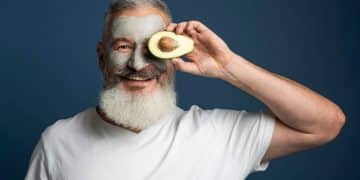DIY Face Masks for Men: Trendsetters or Fleeting Fad?

The emergence of DIY face masks for men in 2025 signifies a growing trend towards personalized skincare and natural remedies, challenging conventional beauty norms and emphasizing the potential for homemade solutions to become a mainstream grooming practice.
In the evolving landscape of men’s grooming, a notable shift is underway. As we approach 2025, the question arises: are DIY face masks for men truly gaining significant popularity, or are they merely a passing fad? This deeply researched article explores the rising interest in homemade remedies, dissecting the motivations, benefits, and potential pitfalls of this burgeoning trend, offering insights into its future trajectory.
The Surging Interest in Natural Skincare for Men
The realm of men’s grooming has long been dominated by straightforward, often minimalist, routines. However, an undeniable pivot towards more nuanced and natural approaches is gaining traction. This shift is not merely about aesthetics but encompasses a holistic view of well-being, where what goes onto the skin is scrutinized as much as what goes into the body. This particular interest in self-prepared skincare solutions suggests a deeper connection men are seeking with their grooming practices.
Understanding the “Why” Behind DIY
Many factors contribute to this growing fascination with homemade remedies. Economic considerations, a desire for natural ingredients free from complex chemicals, and an increasing awareness of environmental impacts play significant roles. Men are increasingly becoming more discerning consumers, seeking products that align with their values and provide tangible benefits without unnecessary additives. This conscious consumption fuels the DIY movement.
- Ingredient Transparency: Knowing exactly what goes into a product builds trust.
- Cost-Effectiveness: Natural ingredients are often more affordable than commercial products.
- Personalization: Masks can be tailored to individual skin types and concerns.
- Sustainability: Reducing packaging waste and reliance on industrial processes.
Moreover, the concept of self-care, once predominantly associated with women, is now openly embraced by men. This expanded definition of self-care includes dedicated time for grooming rituals that promote relaxation and mental well-being. Using a DIY face mask can transform a mundane chore into a meditative ritual, offering a moment of quiet introspection in a bustling world. It’s about taking active control over one’s personal care routine, moving beyond passive consumption to active creation.
This trend is also reinforced by a broader cultural movement towards natural living and a rejection of overly processed goods. From food to fashion, there’s a discernible lean towards authenticity and simplicity. Skincare is no exception. Men are discovering that efficacy doesn’t necessarily come from a laboratory, but can often be found in the pantry. This shift represents a coming-of-age for men’s skincare, signaling a more mature and informed approach to personal care.
Exploring Common Ingredients and Their Benefits
The beauty of DIY face masks lies in the simplicity and accessibility of their ingredients. Many of the most effective components can be found right in your kitchen pantry, offering a stark contrast to the often-intimidating list of chemicals found in commercial products. These readily available items are not only cost-effective but also pack a powerful punch when it comes to skincare benefits.
Nature’s Pharmacy: Key Ingredients for Men’s Skin
When crafting a homemade face mask, understanding the properties of each ingredient is paramount. For men, whose skin often faces unique challenges like razor burn, larger pores, and oiliness, specific ingredients can offer targeted relief and improvement. For instance, ingredients like honey are universally beneficial, renowned for their antibacterial and moisturizing properties, making them suitable for almost all skin types.
- Oats: Ideal for soothing sensitive skin, reducing redness, and offering gentle exfoliation.
- Avocado: Rich in healthy fats and vitamins, perfect for deeply moisturizing dry skin.
- Honey: A natural humectant and antiseptic, excellent for hydration and combating acne.
- Yogurt: Contains lactic acid for mild exfoliation and probiotics that balance skin flora.
The beauty of using these natural elements is that their effectiveness has often been recognized for centuries, long before the advent of modern cosmetic science. Recipes passed down through generations often highlight the powerful healing and beautifying properties of everyday foods. This historical validation adds a layer of trust and authenticity to the DIY approach, encouraging more men to experiment.
Moreover, the act of preparing these masks can be quite satisfying. It’s a hands-on experience that fosters a deeper connection with the products one uses. This personal involvement ensures freshness and allows for immediate adjustments to suit the skin’s daily needs. Rather than a one-size-fits-all solution, homemade masks offer a bespoke skincare experience, reflecting a growing desire for individualized care in the modern world.
The Practicality of DIY Skincare: Time and Effort
While the appeal of natural ingredients and cost savings is significant, the practicality of integrating DIY face masks into a busy schedule is a crucial consideration. Many men lead demanding lives, and the thought of adding another time-consuming ritual to their routine might seem daunting. However, the preparation of most homemade masks is surprisingly quick and straightforward, requiring minimal effort.
Preparing most DIY face masks takes only a few minutes, often less time than it takes to apply a pre-packaged sheet mask. The ingredients are simple to combine, and the cleanup is usually minimal. This ease of preparation helps to debunk the myth that skincare, particularly natural variations, must be a complex or lengthy endeavor. It fits perfectly into a modern lifestyle where efficiency and effectiveness are prized.
Streamlining Your DIY Mask Routine
Efficiency is key when it comes to adopting any new habit. For DIY face masks, this means having the necessary ingredients on hand and knowing simple, quick recipes that deliver results. Planning ahead, much like meal prepping, can make the process even smoother. Identifying versatile ingredients that serve multiple purposes in your kitchen and skincare arsenal reduces waste and streamlines storage.
- Batching: Prepare larger quantities of dry mixtures (like oat blends) for future use.
- Simple Recipes: Focus on masks with 2-3 ingredients for quick application.
- Dedicated Time: Integrate mask application into existing routines, like showering or shaving.
- Accessibility: Store ingredients conveniently in your pantry or bathroom.
The time investment is also offset by the quality of the experience. Unlike a quick splash of water, applying a face mask is an intentional act of self-care. It encourages a pause, a moment to decompress. This brief interlude can effectively contribute to mental well-being, making the small effort of preparation feel far less like a chore and more like a valuable break. It transforms skincare from a mere task into a rejuvenating experience.
Ultimately, the practicality of DIY face masks for men in 2025 will hinge on their ability to integrate seamlessly into diverse lifestyles. As more men seek solutions that are both effective and mindful of their time and resources, the simple, adaptable nature of homemade remedies positions them as a strong contender in the evolving men’s grooming landscape. Their rising popularity underscores a collective move towards informed, deliberate, and accessible self-care.

Addressing Concerns: Safety, Efficacy, and Storage
While the enthusiasm surrounding DIY face masks is growing, it’s crucial to approach their use with a balanced perspective, acknowledging potential concerns regarding safety, efficacy, and proper storage. Not all natural ingredients are suitable for skin application, and improper handling can lead to adverse reactions or a lack of desired results. A well-informed approach ensures both safety and maximum benefit.
One primary concern revolves around skin sensitivity and allergic reactions. Even natural ingredients can trigger adverse responses in some individuals. It’s always advisable to perform a patch test on a small, inconspicuous area of skin (like behind the ear or on the inner forearm) before applying a mask to the entire face. This simple step can prevent widespread irritation or allergic reactions, ensuring a positive experience.
Navigating the Nuances of Homemade Skincare
The efficacy of DIY masks, compared to scientifically formulated commercial products, is another point of discussion. While natural ingredients certainly possess beneficial properties, their concentration and stability in a homemade concoction may vary. Commercial products undergo rigorous testing to ensure consistent potency and shelf-life, something difficult to replicate at home. Homemade masks are best viewed as complementary treatments, rather than a full replacement for professionally formulated skincare.
- Patch Test: Always test new ingredients on a small skin area first.
- Ingredient Freshness: Use fresh ingredients to maximize potency and minimize bacterial growth.
- Proper Storage: Store homemade masks in airtight containers in the refrigerator for a short period.
- Avoid Irritants: Be cautious with highly acidic ingredients like pure lemon juice, which can cause photosensitivity.
Storage is also a pivotal aspect that often gets overlooked. Unlike commercial products with preservatives, homemade masks are perishable. They are susceptible to bacterial growth, especially if not stored correctly or used promptly. Most DIY masks should be discarded after a few days, even if refrigerated, to prevent contamination and maintain efficacy. This short shelf-life means they are not ideal for long-term batch preparation.
Moreover, the notion that “natural” inherently means “safe” is a misconception. Certain natural substances, like essential oils in high concentrations or photosensitive ingredients like citrus, can be irritating or even harmful if not used correctly. Education on proper ingredient selection and dilution is paramount. By addressing these concerns proactively, men can comfortably and safely explore the benefits of homemade face masks, leveraging their potential while mitigating risks.
Sustainability and Ethical Considerations in DIY Grooming
The rising popularity of DIY face masks for men is not merely a trend in personal care; it also reflects a growing consciousness around sustainability and ethical consumption. As consumers become more aware of the environmental and social impacts of their purchasing decisions, homemade remedies offer an appealing alternative to mass-produced cosmetics. This alignment with broader eco-conscious values adds another layer to their increasing adoption.
One of the most significant environmental benefits of DIY grooming is the reduction of packaging waste. The cosmetic industry produces a vast amount of plastic and non-recyclable containers. By making products at home, individuals can significantly cut down on their personal waste footprint, opting for reusable containers or simply using ingredients directly from their food pantry. This small change, when scaled, can have a considerable positive impact.
Conscious Choices: Beyond the Bottle
The ingredients used in DIY masks often come with a clearer, more transparent supply chain than those in commercial products. When sourcing ingredients like honey, oats, or avocados, consumers can typically choose organic, locally sourced, or fair-trade options, promoting ethical production and reducing carbon emissions associated with long-distance transport. This level of control over ingredient sourcing is nearly impossible with pre-packaged goods.
- Reduced Packaging: Significantly less plastic and non-recyclable waste.
- Local Sourcing: Supports local farmers and reduces carbon footprint.
- Ethical Production: Ability to choose ingredients with clear, humane origins.
- Waste Reduction: Utilizing food items that might otherwise go unused.
Beyond environmental concerns, there’s an ethical dimension to ingredient cultivation. Many commercial cosmetic ingredients are derived from processes that may involve unsustainable farming practices, exploitation of labor, or animal testing. DIY skincare allows individuals to opt out of these systems, choosing cruelty-free and ethically produced components, supporting a more responsible global supply chain. This active participation in ethical consumption is empowering.
Furthermore, the DIY movement encourages a holistic approach to consumption, where an item’s journey from source to skin is considered. It’s about making deliberate choices that resonate with one’s values, rather than simply consuming what’s readily available. As men become more engaged in these broader discussions around sustainability and ethics, the appeal of DIY face masks extends far beyond personal grooming, becoming an expression of their conscious lifestyle.
The Future Landscape: Mainstream Acceptance and Innovation
As we look towards 2025 and beyond, the trajectory of DIY face masks for men suggests a move towards broader mainstream acceptance, rather than fading into obscurity. This isn’t just a niche hobby for a select few; it’s a reflection of deeper societal shifts towards natural living, conscious consumption, and personalized well-being. The innovation within this space will likely involve more accessible information and sophisticated ingredient knowledge.
The future might see a greater integration of dermatological insights with home remedies. While traditional natural medicine has always informed some practices, modern science can now validate and refine these approaches, providing men with clearer guidelines on effective ingredient combinations and application techniques. Online communities and dedicated platforms could emerge, sharing verified recipes and scientific backing for various ingredients.
Evolving Trends: Workshops and Curated Kits
The market for DIY might also adapt to meet the growing demand. Instead of simply buying raw ingredients, we could see the rise of curated DIY mask kits, offering pre-measured, high-quality natural components along with detailed instructions. This would appeal to those who seek the benefits of homemade products but prefer a more streamlined, less overwhelming entry point. Workshops focused on DIY skincare could become popular, educating consumers on safe and effective practices.
- Educational Platforms: More accessible information on ingredient science and skin types.
- Curated DIY Kits: Pre-packaged ingredient sets for convenience.
- Interactive Workshops: Hands-on learning for safe and effective mask preparation.
- Customization Tools: Apps or platforms that help men identify ideal ingredients for their skin.
Moreover, the burgeoning influencer culture on social media will undoubtedly play a significant role. As more male figures champion transparent and natural skincare, showing tangible results from their DIY routines, the trend will gain further momentum and credibility. Visual platforms like Instagram and TikTok are perfectly suited for showcasing the simplicity and effectiveness of homemade masks, turning them into aspirational practices.
Ultimately, the future of DIY face masks for men in 2025 is bright. It represents more than just a trend; it signifies a maturing of men’s grooming practices, moving towards more intentional, sustainable, and personalized solutions. The blend of ancient wisdom and modern scientific understanding, coupled with a growing social consciousness, positions DIY masks not as a fleeting fad, but as a lasting, evolving component of holistic men’s well-being.

Integrating DIY into a Comprehensive Skincare Regimen
While DIY face masks for men offer numerous benefits and are certainly gaining momentum, they are best viewed as a complementary part of a broader, comprehensive skincare regimen rather than a standalone solution. Achieving optimal skin health typically requires a multi-faceted approach that addresses daily cleansing, moisturizing, and protection from environmental factors. Homemade masks can enhance these foundational steps.
The role of a DIY mask, therefore, is to provide targeted treatments: deep hydration, gentle exfoliation, soothing irritation, or balancing oil production. They can be incorporated once or twice a week, much like a potent serum or specialized treatment. This strategic integration allows men to enjoy the unique benefits of fresh, natural ingredients without neglecting the essential daily care that commercial products often provide more conveniently and consistently.
Synergy Between Homemade and Commercial Products
A common misconception is that one must choose exclusively between natural, homemade remedies and commercially available products. In reality, the most effective skincare routines often combine the best of both worlds. A man might use a gentle commercial cleanser daily, alongside a high-quality, broad-spectrum SPF, and then supplement this with a weekly DIY mask tailored to specific concerns. This synergy maximizes benefits.
- Daily Essentials: Commercial cleanser, moisturizer, and SPF remain crucial.
- Targeted Treatment: DIY masks act as weekly boosters for specific concerns.
- Ingredient Complementarity: Use ingredients in masks that support your daily routine.
- Consistency: The key to effective skincare, whether with DIY or commercial products.
Furthermore, the experience of creating and applying a DIY mask can foster a deeper understanding of one’s own skin. By observing how different natural ingredients affect their complexion, men can become more attuned to their skin’s needs and how it reacts to various treatments. This heightened awareness empowers them to make more informed decisions about all aspects of their skincare, whether buying off the shelf or mixing their own.
Ultimately, the integration of DIY face masks into a man’s skincare regimen is about choice, personalization, and informed decision-making. As the trend strengthens towards 2025, it emphasizes that sophisticated skincare doesn’t have to be complicated or confined to a single source. Instead, it’s an evolving journey where homemade remedies stand proudly alongside trusted commercial products, all serving the common goal of healthier, well-cared-for skin.
| Key Point | Brief Description |
|---|---|
| 🌱 Natural Appeal | Growing male interest in natural, chemical-free skincare with visible benefits. |
| 💰 Cost-Effective | Utilizes common household ingredients, saving money compared to commercial products. |
| ⏰ Time Efficient | Most masks are quick to prepare and apply, fitting into busy routines. |
| 🌍 Eco-Conscious | Reduces packaging waste and supports ethical sourcing, aligning with sustainability. |
Frequently Asked Questions About DIY Face Masks for Men
While generally safe, it’s crucial to perform a patch test on a small, inconspicuous area of skin before applying any DIY mask to your entire face. This helps identify potential allergic reactions or sensitivities to specific natural ingredients, ensuring a comfortable and safe experience for various skin types.
For most men, using a DIY face mask once or twice a week is generally sufficient for optimal benefits. Overuse can potentially over-exfoliate or irritate the skin, depending on the ingredients. Listen to your skin’s needs and adjust the frequency accordingly, integrating it into your existing grooming routine.
Excellent starting ingredients include oats for soothing, honey for hydration, avocado for moisturizing, and plain yogurt for mild exfoliation. These are generally gentle, versatile, and readily available in most kitchens, making them perfect for those new to crafting their own skincare remedies.
Homemade masks can be highly effective for specific concerns due to their fresh, potent natural ingredients. However, their consistency and preservative-free nature mean they might not offer the same concentrated, long-term stability or broad spectrum of benefits as scientifically formulated commercial products. They act as excellent complementary treatments.
Due to the lack of preservatives, store any leftover DIY face mask mixtures in an airtight container in the refrigerator for no more than 2-3 days. Discard any mixture that changes color, scent, or shows signs of spoilage to ensure safety and prevent bacterial contamination on your skin.
Conclusion
The exploration into whether DIY face masks for men are gaining popularity in 2025 reveals a clear affirmative. This isn’t just a fleeting trend but a nuanced reflection of evolving societal values, where a desire for natural ingredients, sustainability, and personal empowerment converge. As men increasingly prioritize holistic well-being and conscious consumption, the simple yet effective act of crafting one’s own skincare offers a compelling alternative to traditional grooming. The future of men’s skincare looks set to be more personalized, informed, and intrinsically linked to natural, accessible solutions.





